Weathering and Mass Wasting
Introduction to Rocks and the Rock Cycle
- Types of Rocks: There are three main types of rocks on Earth:
- Igneous Rocks: Formed from cooled lava after volcanic eruptions; they are the first rocks to form on Earth’s surface.
- Sedimentary Rocks: Formed from the accumulation and compaction of sediments, often mixed with organic materials, under immense pressure.
- Metamorphic Rocks: Formed when igneous or sedimentary rocks are subjected to intense heat and pressure, transforming their structure.
- Rock Cycle (Fig. 2.1):
- Chronology of Origin: Igneous → Sedimentary → Metamorphic.
- Process: Igneous rocks break into sediments, which form sedimentary rocks through deposition and compaction. These rocks transform into metamorphic rocks under heat and pressure, and the cycle continues as they may melt and reform as igneous rocks.
- Sedimentary Rock Formation: Sediments are transported, deposited in layers, and compacted under pressure with cementing materials, forming sedimentary rocks over time.
Weathering
- Definition: Weathering is the physical or chemical breakdown of rocks due to weather conditions, occurring in-situ (without significant movement of materials).
- Effects: Leads to the disintegration of rock grains, weakening them, and eventually causing erosion. It also smooths sharp edges of rocks.
Types of Weathering
- Physical Weathering: Breakdown of rocks into smaller pieces without chemical change.
- Chemical Weathering: Breakdown involving chemical reactions that alter the rock’s composition.
Factors Affecting Weathering
1. Water
Role: Water enters pores, cracks, and fissures in rocks, influenced by the climate.
Freeze-and-Thaw Weathering (Fig. 2.2):
- Occurs in regions with high diurnal temperature ranges (e.g., high altitudes, mid/low latitudes, mountainous areas).
- Water in cracks freezes at night, expands (increasing volume), and exerts pressure, widening cracks. During the day, it thaws, and the cycle repeats, eventually breaking the rock.
- Effective on: Sedimentary rocks like sandstone, grit, and conglomerate.
Chemical Effects:
- Hydrolysis: Water reacts with minerals (e.g., silicates in igneous rocks), forming new compounds that break the rock.
- Solution: Minerals (e.g., calcium, magnesium) dissolve in water, forming acids (e.g., carbonic acid in limestone), leading to rock decomposition.
Note: Moisture in soil or air can also contribute to both physical and chemical weathering.
2. Oxygen
Oxidation (Fig. 2.3):
- Oxygen reacts with metals in rocks (e.g., iron, aluminum), forming oxides (iron oxides: red; aluminum oxides: yellow).
- Oxides are softer, larger in volume, and change the rock’s color (e.g., rust on iron/steel).
3. Carbon Dioxide
Carbonation:
- CO2 from air or decomposing organic matter reacts with minerals (e.g., feldspar, carbonates in limestone).
- In humid climates, water enhances the reaction, detaching calcium and carbonate ions, decomposing the rock.
- In arid climates, carbonate rocks (e.g., limestone) form resistant cliffs due to lack of water.
- Often occurs with solution simultaneously.
4. Salt
Salt Weathering (Fig. 2.4):
- Salts (e.g., calcium, sodium) in rocks expand due to thermal properties, splitting grains and causing physical weathering.
- Common in areas with alternating wet/dry periods and coastal regions (e.g., Hareshwar, Raigad), forming honeycomb structures.
- Combines physical and chemical weathering effects.
5. Heat
Granular Weathering (Fig. 2.5):
- In hot deserts with high diurnal temperature ranges, minerals expand and contract differently, creating stresses that break individual grains.
Shattering (Fig. 2.6):
- Rocks break due to intense heat, producing a pistol-like sound in deserts.
Block Disintegration (Fig. 2.7):
- In jointed rocks (e.g., granite), repeated expansion/contraction widens joints, breaking rocks into blocks.
Note: Heat indirectly speeds up chemical weathering by enhancing reaction rates.
6. Pressure
- Exfoliation (Fig. 2.8):
- Occurs when underlying rocks are exposed to lower pressure after the removal of overlying rocks.
- The outer layers expand outward, separating from the lower layers, forming dome-shaped structures (e.g., Deccan Plateau: Karnataka, Andhra Pradesh).
- Common in homogeneous igneous rocks like granite.
7. Biological Weathering (Fig. 2.9 A & B)
- Definition: Disintegration of rocks due to living organisms.
- Plant Roots:
- Roots penetrate cracks, widen them as they grow, and break rocks apart.
- Plants growing in fissures also contribute to disintegration.
- Microorganisms:
- Algae, moss, lichens, and bacteria grow on rock surfaces, secreting chemicals that erode the outer layer.
- Creates moist micro-environments that enhance chemical and physical breakdown.
- Animals:
- Burrowing animals widen fissures, speeding up weathering.
- Note: The extent of biological activity depends on the local ecosystem.
8. Anthropogenic Weathering
- Definition: Human activities that accelerate weathering.
- Examples:
- Mining, blasting for roads/dams, quarrying, and deforestation expose rocks to weathering.
- These activities achieve in a short time what natural weathering takes thousands to millions of years.
- Air Pollution:
- Burning fossil fuels releases nitrogen oxides and sulfur dioxide, forming acid rain.
- Acid rain damages limestone/marble structures (e.g., Parthenon in Greece, Taj Mahal in India, Great Sphinx in Egypt).
Differential Rates of Weathering
- Rock Type and Structure:
- Quartzite: Hard, resistant to chemical weathering but fractures physically.
- Limestone: Resists in arid conditions but weathers easily in humid regions.
- Granite: Resists in arid regions, but its minerals are prone to chemical weathering.
- Structure:
- Rocks with joints/fractures weather faster.
- Larger grains allow more water entry, speeding up weathering.
- Homogeneous rocks (e.g., granite) are harder to break than layered rocks (e.g., sedimentary rocks).
- Climate Impact:
- Physical and chemical weathering often work together, but one dominates based on climate.
- Chemical weathering is rapid in humid climates; physical weathering dominates in arid regions.
- Example: In a region with 5°C annual mean temperature and 1000 mm rainfall, chemical weathering (e.g., hydrolysis, carbonation) would dominate due to moisture, likely in mid-latitude or mountainous regions.
Mass Wasting
- Definition: Down-slope movement of soil, land, and rock particles under gravity, without a transporting medium (e.g., water, wind, ice).
- Nature: Occurs continuously on all slopes; some movements are slow, others sudden and disastrous.
Factors Affecting Mass Wasting
- Relief and Slope:
- Requires considerable elevation; more common in hilly, mountainous, and plateau areas.
- Steeper slopes lead to rapid movements; gentle slopes have slower movements.
- Gravity:
- The main force pulling materials downslope.
- Water:
- Adds weight to materials (e.g., rainfall, snowmelt), reducing friction along sliding surfaces.
- Increases the likelihood of mass wasting.
- Weak Material and Structures:
- Jointed rocks or those with clay/calcium minerals are more susceptible.
- Clay prevents water percolation, saturating surface layers and causing slides.
- Vegetation:
- Roots stabilize slopes; deforestation increases mass wasting risk.
- Human Activity:
- Construction and irrigation add weight to slopes, reducing friction.
- Climate:
- Humid climates with heavy rainfall (e.g., Himalayas) are prone to slides.
- Snowmelt in mountainous regions increases soil water content, triggering movements.
Types of Mass Wasting (Fig. 2.12)
- Fall or Topple:
- Rapid free fall of rocks down a slope/cliff, landing at the bottom.
- Common in rocky areas.
- Flows:
- Mixture of water, rock, and weathered material moving quickly.
- Large flows can bury villages; smaller ones block roads.
- Example: Earth flow in humid regions.
- Slide:
- A section of soil/rock moves downslope as a single mass along a slippery zone.
- Occurs on moderately steep slopes.
- Creep:
- Very slow movement (years/centuries), often along hilltops or basal portions.
- Example: Solifluction in periglacial regions, a slow creep of oversaturated soil over permafrost.
- Note: Speed and water content determine the type (Fig. 2.12 schematic diagram: creep is slow/dry, flow is fast/wet).
Importance of Weathering and Mass Wasting
- Weathering:
- Prepares materials for erosion, leading to soil and landform formation (e.g., deltas, beaches, plains).
- Enriches ores (e.g., laterite, bauxite) through leaching in high-rainfall areas.
- Mass Wasting:
- Shapes landscapes by moving materials downslope, contributing to landform development.
- Can lead to disasters (e.g., Malin village mudslide, 2014, near Pune, due to heavy rainfall and slope, p. 21).
Weathering vs. Erosion
- Weathering:
- In-situ breakdown of rocks (physical/chemical).
- No significant movement of materials.
- Erosion:
- Involves segregation and transport of rock particles by agents (wind, water, ice) under gravity or pressure differences.
- Kinetic energy is applied to move materials.
Key Points to Remember
- Rock Susceptibility:
- Sedimentary rocks break more easily than igneous rocks due to joints/layers.
- Homogeneous rocks are more resistant.
- Regional Variations:
- Freeze-thaw weathering is ineffective in regions with low diurnal temperature ranges (e.g., tropics).
- Landslides are frequent in Himalayan foothills and Western Ghats due to steep slopes, heavy rainfall, and deforestation, but rare in flat, dry areas like Marathwada or Maidan (Karnataka).
- Human Impact:
- Stone quarrying causes physical weathering by breaking rocks mechanically.

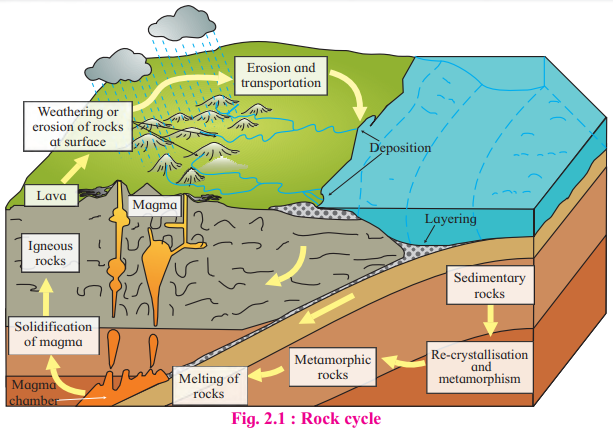
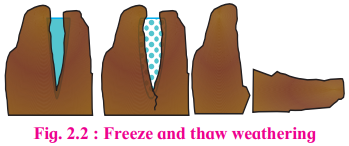






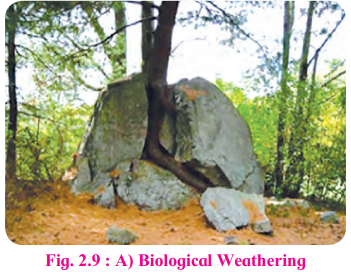
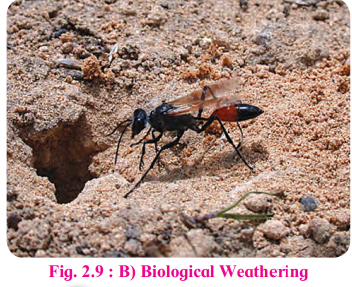
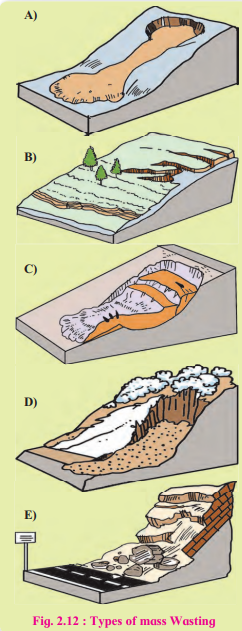
Leave a Reply